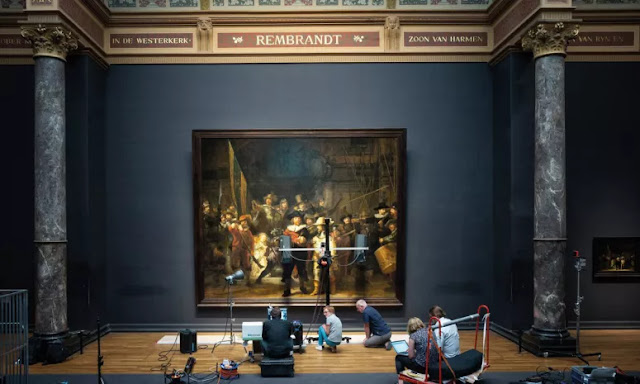Generally, seeing art on a computer screen is never as good as seeing art in real life. At Glasstire, we’ve always espoused this statement, and I do firmly believe it still.
However, there are certain times when seeing an artwork online — and the capabilities offered by digital technologies — comes close to eclipsing the live experience.
Maybe this isn’t for me to judge, as I’ve never been to Amsterdam’s Rijksmuseum, but the institution’s recent online offering of a 717-gigapixel (that’s 717,000,000,000 pixels) image of Rembrandt van Rijn’s The Night Watch (1642) is very compelling, and perhaps even better than seeing the nearly 15-foot-wide canvas in person.
Rembrandt van Rijn, “The Night Watch,” 1642, Oil on canvas, 379.5 cm × 453.5 cm. Collection of the Rijksmuseum
There’s been a lot of work done on and press about the painting recently. In June of last year, Artnet News reported that, with the help of artificial intelligence, museum experts were able to reconstruct missing sections of the painting, which were lost after the work was trimmed so it could fit inside Amsterdam’s Town Hall in 1715. This was just the latest revelation during the Rijksmuseum’s ongoing effort to conserve and restore the painting, which began in 2019. Likely because the piece is so well-known (and because the public wouldn’t want it to disappear for years into a back room), conservators worked on the painting in a glass chamber, in full view of the public.
The process of how this 717-gigapixel photo came to be is stunning, and the level of detail it makes legible is more stunning still. See information about the process below, via the Rijksmuseum. And see (and zoom into!) the photo here.
This is the largest and most detailed photo ever taken of a work of art. It is 717 gigapixels, or 717,000,000,000 pixels, in size.
The distance between two pixels is 5 micrometres (0.005 millimetre), which means that one pixel is smaller than a human red blood cell.
The team used a 100-megapixel Hasselblad H6D 400 MS-camera to make 8439 individual photos measuring 5.5cm x 4.1cm. Artificial intelligence was used to stitch these smaller photographs together to form the final large image, with a total file size of 5.6 terabytes.





